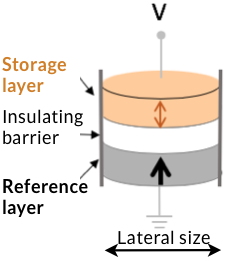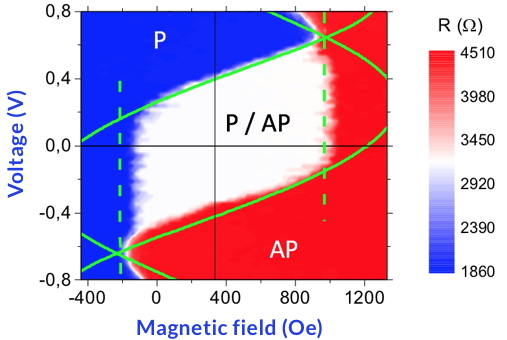Random Access Magnetic Memories (MRAMs) are spintronic devices combining non-volatility (keep the data without power supply), speed and robustness against radiation. They are intended to become one of the basic building blocks of future neuromorphic devices and / or architectures (e.g. neural network). At the heart of the component, there is a magnetic tunnel junction consisting of two ferromagnetic layers (reference and storage) separated by an insulating barrier (
Figure 1). The most promising approaches are based on the configuration so-called perpendicular magnetic tunnel junctions for which the magnetizations of the two ferromagnetic layers are perpendicular to their plane.
 Figure 1: Diagram of a nano-pillar JTM. Depending on the parallel or antiparallel orientation of the magnetization between the two ferromagnetic layers (arrows), the electrical resistance of the junction will be low or high, thus encoding the binary information. One of these layers, called reference, has a fixed magnetization during operation of the memory point. The second, or storage layer, is used to record the information via its magnetization which, during writing, changes under the action of a voltage step of a few nanoseconds.
Figure 1: Diagram of a nano-pillar JTM. Depending on the parallel or antiparallel orientation of the magnetization between the two ferromagnetic layers (arrows), the electrical resistance of the junction will be low or high, thus encoding the binary information. One of these layers, called reference, has a fixed magnetization during operation of the memory point. The second, or storage layer, is used to record the information via its magnetization which, during writing, changes under the action of a voltage step of a few nanoseconds. To increase the integration density of the memories, the lateral size of the magnetic junction (Figure 1) is constantly reduced, but this generates a sharp increase in the current required for writing. Naturally, as a consequence the Joule effect become important and lead to the heating of the storage layer whose magnetic properties are disturbed. The magnetic behavior thus deviates from the desired standard behavior. Therefore, the reversal of the magnetization is no longer precisely controlled and the operation of the memory point is challenged.
Researchers at IRIG have adjusted the modelling approach, which is usually used to describe the magnetization reversal, taking into account the Joule effect. In this novel model, the magnetization of the storage layer is uniform and its orientation free to evolve with the field and / or the applied current (pulse). During the pulse, the temperature variation, due to the Joule effect, impacts several magnetic parameters of the system that are calculated. A calibration of this model (
Figure 2) was carefully performed to accurately describe the behavior of the perpendicular junctions regardless of the applied voltage, and thus determine the stability points (field, voltage) of operation.
 Figure 2: Field-voltage diagram measured experimentally. The blue color indicates the parallel state of the two ferromagnetic layers (P, low electrical resistance), the red indicates the anti-parallel state (AP, high electrical resistance). White is the bi-stability zone (P / AP). Green lines are the stability lines from modeling.
Figure 2: Field-voltage diagram measured experimentally. The blue color indicates the parallel state of the two ferromagnetic layers (P, low electrical resistance), the red indicates the anti-parallel state (AP, high electrical resistance). White is the bi-stability zone (P / AP). Green lines are the stability lines from modeling. The interest of this new model lies in its generality being applicable to various kinds of magnetic tunnel junction of lateral nanometric size. In the close future, the model will be integrated into microelectronic design tools.